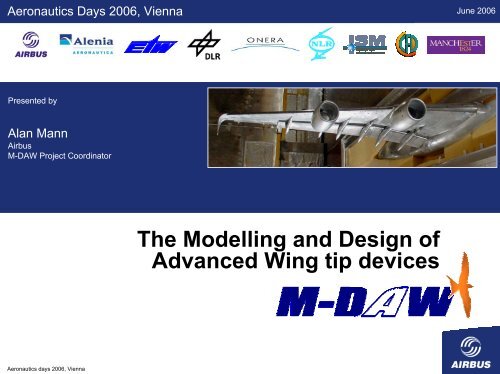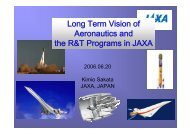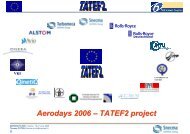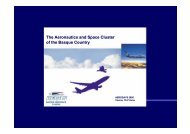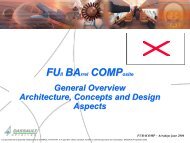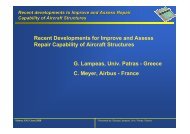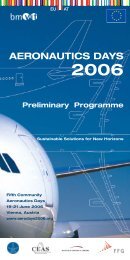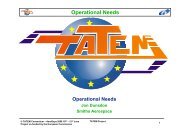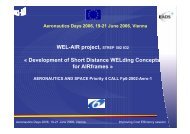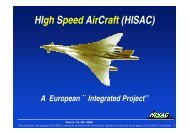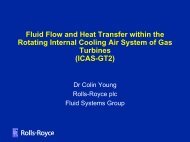The Modelling and Design of Advanced Wing tip devices
The Modelling and Design of Advanced Wing tip devices
The Modelling and Design of Advanced Wing tip devices
You also want an ePaper? Increase the reach of your titles
YUMPU automatically turns print PDFs into web optimized ePapers that Google loves.
Aeronautics Days 2006, Vienna<br />
June 2006<br />
Presented by<br />
Alan Mann<br />
Airbus<br />
M-DAW Project Coordinator<br />
<strong>The</strong> <strong>Modelling</strong> <strong>and</strong> <strong>Design</strong> <strong>of</strong><br />
<strong>Advanced</strong> <strong>Wing</strong> <strong>tip</strong> <strong>devices</strong><br />
Aeronautics days 2006, Vienna
<strong>Advanced</strong> <strong>Wing</strong> Tips – <strong>The</strong> Strategic Challenge<br />
© AIRBUS UK LTD. All rights reserved. Confidential <strong>and</strong> proprietary document.<br />
• European Aeronautics Vision for 2020 http://www.acare4europe.org<br />
Quality <strong>and</strong> Affordability (continuous improvement)<br />
– Reduced drag<br />
<strong>The</strong> Environment (reduced impact <strong>of</strong> increased traffic)<br />
– 50% cut in CO 2 (≡ 50% cut in fuel burn), 20-25% via airframe<br />
– 50% cut in perceived noise<br />
Safety (reduced accidents with increased traffic)<br />
Efficiency <strong>of</strong> the Air Transport System<br />
Security<br />
• <strong>The</strong> 2020 Vision represents a Step change in performance<br />
Novel concepts required<br />
• <strong>Wing</strong>lets identified as key technology <strong>of</strong>fering potential in short term<br />
Benefits at all stages <strong>of</strong> flight<br />
Retr<strong>of</strong>it onto existing products<br />
• M-DAW covers the Novel end <strong>of</strong> a coordinated <strong>Wing</strong>let Research<br />
Activity<br />
Aeronautics days 2006, Vienna June 2006 Page 2
<strong>Advanced</strong> <strong>Wing</strong> Tips – <strong>The</strong> Technical Challenge<br />
• <strong>Wing</strong>let design is a balance between Aerodynamic benefits <strong>and</strong><br />
Structural penalties<br />
∆WRBM due to aerodynamic forces<br />
Each <strong>Wing</strong>let curve represents an increasing load for constant winglet planform<br />
Impact <strong>of</strong> <strong>Wing</strong>let retr<strong>of</strong>it on Rigid <strong>Wing</strong><br />
Drag<br />
reduction<br />
Small<br />
<strong>Wing</strong>lets<br />
Off <strong>Design</strong> Mach No.<br />
(Increasing Shock<br />
Strengths)<br />
© AIRBUS UK LTD. All rights reserved. Confidential <strong>and</strong> proprietary document.<br />
WRBM = “<strong>Wing</strong> Root Bending Moment”<br />
Large<br />
<strong>Wing</strong>lets<br />
AIRCRAFT<br />
OPTIMUM<br />
WINGLET<br />
AERODYNAMIC<br />
OPTIMUM<br />
Aeronautics days 2006, Vienna June 2006 Page 3
<strong>Advanced</strong> <strong>Wing</strong> Tips – <strong>The</strong> M-DAW Objective<br />
“To Deliver to the European Aerospace Industry a Novel <strong>Wing</strong> Tip Device<br />
to Improve Aircraft Efficiency <strong>and</strong> Environmental Impact together with a<br />
Capability to Accurately Predict the Effect <strong>of</strong> <strong>Wing</strong> Tip Device <strong>Design</strong> on<br />
Aircraft Performance”<br />
© AIRBUS UK LTD. All rights reserved. Confidential <strong>and</strong> proprietary document.<br />
• Develop a deeper underst<strong>and</strong>ing <strong>of</strong> the aerodynamics <strong>of</strong> wing <strong>tip</strong> <strong>devices</strong><br />
Delivering a unique <strong>and</strong> extensive experimental database<br />
• Assess the capabilities <strong>of</strong> advanced CFD to predict <strong>tip</strong> device effects<br />
Delivering validated flow simulation methods<br />
• Explore novel wing <strong>tip</strong> device concepts<br />
Delivering an assessment <strong>of</strong> a range <strong>of</strong> advanced wing <strong>tip</strong> device concepts<br />
• Demonstrate the most promising device by wind tunnel testing<br />
Delivering a demonstrated performance improvement by an advanced wing <strong>tip</strong><br />
device<br />
• M-DAW performance targets were stated as<br />
A further 1% reduction in aerodynamic drag at cruise<br />
A 2% increase in L/D at take-<strong>of</strong>f<br />
Relative to a wing with a conventional <strong>tip</strong> device for a constant aerodynamic wing<br />
root bending moment in cruise<br />
Aeronautics days 2006, Vienna June 2006 Page 4
<strong>The</strong> M-DAW Project Plan<br />
WP1 Experimental Investigation<br />
Conventional Baseline Performance<br />
Validation Data<br />
Detailed Study <strong>of</strong> Flow Physics<br />
2003 2004 2005<br />
2006<br />
Low<br />
M1.2 M1.1<br />
High<br />
M1.3<br />
WP2 Application <strong>of</strong> CFD<br />
Validated CFD <strong>Design</strong> & Analysis Capability<br />
M2.1 M2.2<br />
© AIRBUS UK LTD. All rights reserved. Confidential <strong>and</strong> proprietary document.<br />
WP3 Novel <strong>Wing</strong> Tip Device <strong>Design</strong><br />
Study <strong>of</strong> a Range <strong>of</strong> Concepts Combining to<br />
Deliver One Novel Device<br />
WP4 Assessment, Selection & Demonstration<br />
Selection & Demonstration <strong>of</strong> One Novel Device<br />
Aeronautics days 2006, Vienna June 2006 Page 5<br />
M3.1<br />
Over 330 person months plus 1.8 Million € costs<br />
M3.2<br />
M4.1M4.2 M4.3<br />
M4.4<br />
M4.5<br />
High<br />
& Low<br />
M4.6<br />
M5.1
M-DAW – CFD Validation <strong>and</strong> <strong>Wing</strong> Deformation<br />
M = 0.2, Re = 7.2×10 6<br />
4<br />
Lines – N-S CFD<br />
Symbols – WTT<br />
Küchemann (TAU)<br />
Küchemann (KKK)<br />
large wglt. (TAU)<br />
large wglt. (KKK)<br />
Black – Küchemann<br />
Red – <strong>Wing</strong>let<br />
2<br />
η = 0.56<br />
0<br />
0.0 0.2 0.4 0.6 0.8 1.0<br />
η<br />
© AIRBUS UK LTD. All rights reserved. Confidential <strong>and</strong> proprietary document.<br />
Lines – N-S CFD<br />
Symbols – WTT<br />
50% <strong>Wing</strong>let<br />
TAU<br />
KKK<br />
0.0 0.2 0.4 0.6 0.8 1.0<br />
η<br />
Aeronautics days 2006, Vienna June 2006 Page 6
M-DAW – CFD Validation <strong>and</strong> <strong>Wing</strong> Deformation<br />
Kuchemann Tip<br />
M = 0.85, Re = 54.2×10 6 ,<br />
α = 1.5º<br />
Improvement due to<br />
accurate simulation <strong>of</strong><br />
half model effects<br />
Improvement due to<br />
accurate simulation <strong>of</strong><br />
deformation effects<br />
• CFD has proved<br />
valuable in the<br />
development <strong>of</strong> a<br />
new <strong>tip</strong> concept<br />
• A combination <strong>of</strong><br />
CFD <strong>and</strong> WTT is<br />
required to<br />
assess<br />
performance<br />
Stereo Pattern Tracking<br />
Markers on M-DAW model<br />
© AIRBUS UK LTD. All rights reserved. Confidential <strong>and</strong> proprietary document.<br />
Aeronautics days 2006, Vienna June 2006 Page 7<br />
16mm<br />
8µm thick
M-DAW – <strong>Advanced</strong> <strong>Wing</strong> Tip <strong>Design</strong> Activities<br />
• <strong>Design</strong> Studies Based on:<br />
Retr<strong>of</strong>it scenario<br />
“Equivalent Drag”<br />
• <strong>Design</strong> Studies Included:<br />
Novel shapes<br />
Optimised shapes<br />
Movable elements<br />
Aeroelastic <strong>and</strong><br />
Structural effects<br />
∆C Dequiv<br />
= ∆C Dest<br />
+ ∆C Dtrim<br />
+ ∆C D1gwrbm<br />
+ ∆C Dweight + mech<br />
© AIRBUS UK LTD. All rights reserved. Confidential <strong>and</strong> proprietary document.<br />
Equiv<br />
Drag<br />
Small<br />
WRBM<br />
Trade<br />
Equiv<br />
Drag<br />
Large<br />
WRBM<br />
Trade<br />
0.0º 0.0º<br />
Aeronautics days 2006, Vienna June 2006 Page 8
M-DAW – <strong>Advanced</strong> Downward Tip <strong>Design</strong><br />
© AIRBUS UK LTD. All rights reserved. Confidential <strong>and</strong> proprietary document.<br />
• Approach<br />
Vortex Lattice Method study<br />
Euler optimisation<br />
N-S analysis<br />
• Small Downward Device<br />
Modest drag reduction<br />
Good WRBM behaviour<br />
• Analysis<br />
High <strong>and</strong> low speed<br />
Lateral stability<br />
High-g structural impact<br />
Additional lift due<br />
to <strong>tip</strong> device<br />
Aeronautics days 2006, Vienna June 2006 Page 9
M-DAW – <strong>Advanced</strong> Downward Tip Assessment<br />
Dihedral winglet:<br />
Favorable trend<br />
Anhedral winglet:<br />
Detrimental trend<br />
© AIRBUS UK LTD. All rights reserved. Confidential <strong>and</strong> proprietary document.<br />
Incremental Local Bending Moment Due<br />
to Downward Device<br />
0.0<br />
<strong>Wing</strong> Span<br />
M 0.86, -0.8g<br />
M 0.86, 1g<br />
M 0.86, 1.8g<br />
Vertical<br />
Downward<br />
Device:<br />
Structural impact<br />
remains negligible<br />
even at high-g<br />
Aeronautics days 2006, Vienna June 2006 Page 10
M-DAW – <strong>Advanced</strong> Downward Tip Demonstration<br />
© AIRBUS UK LTD. All rights reserved. Confidential <strong>and</strong> proprietary document.<br />
• Demonstrated in high <strong>and</strong> low<br />
speed tests at ETW<br />
• <strong>The</strong> performance <strong>of</strong> the M-DAW<br />
novel concept has been broadly<br />
confirmed<br />
• Good agreement with drag<br />
predictions for attached flow<br />
<strong>devices</strong><br />
• <strong>The</strong> SPT wing deformation<br />
method confirmed the expected<br />
negligible high speed penalty <strong>of</strong><br />
the novel device<br />
Drag Reduction<br />
<strong>Wing</strong>let<br />
Aeronautics days 2006, Vienna June 2006 Page 11<br />
WTT<br />
N-S CFD<br />
CL<br />
Fence<br />
Downward<br />
Device
M-DAW – WTT High Speed C D Increments<br />
Test Results Summary<br />
© AIRBUS UK LTD. All rights reserved. Confidential <strong>and</strong> proprietary document.<br />
• Large winglet <strong>of</strong>fers best drag<br />
reduction<br />
• Fence is insensitive to Reynolds<br />
Number<br />
• Attached flow Downward Device<br />
behaves as <strong>Wing</strong>let<br />
Aeronautics days 2006, Vienna June 2006 Page 12
M-DAW – WTT High Speed C Roll Increments<br />
Test Results Summary<br />
• Large winglet has a significant<br />
impact on Rolling Moment <strong>and</strong><br />
thus structural sizing<br />
• Fence <strong>and</strong> Downward Device<br />
both display low Bending Moment<br />
penalties<br />
© AIRBUS UK LTD. All rights reserved. Confidential <strong>and</strong> proprietary document.<br />
Aeronautics days 2006, Vienna June 2006 Page 13
M-DAW – WTT Low Speed C D Increments<br />
Test Results Summary<br />
© AIRBUS UK LTD. All rights reserved. Confidential <strong>and</strong> proprietary document.<br />
• Large winglet <strong>of</strong>fers the largest<br />
span <strong>and</strong> largest low speed<br />
performance benefit<br />
• Fence is not primarily a low speed<br />
device<br />
• Attached flow Downward Device<br />
<strong>of</strong>fers an improvement over the<br />
Fence<br />
Aeronautics days 2006, Vienna June 2006 Page 14
M-DAW – Generic <strong>Design</strong> Conclusions<br />
© AIRBUS UK LTD. All rights reserved. Confidential <strong>and</strong> proprietary document.<br />
• <strong>The</strong> optimum wing <strong>tip</strong> device will change depending on the aircraft <strong>and</strong><br />
project context<br />
• <strong>The</strong> multi-disciplinary trades, <strong>and</strong> especially the impact on the wing<br />
bending moments, can dominate the high speed design process<br />
• Structural <strong>and</strong> aeroelastic studies, including high-g loads, are an<br />
integral part <strong>of</strong> the design <strong>and</strong> analysis process<br />
<strong>The</strong> focus <strong>of</strong> advanced cryogenic wind tunnel test techniques in M-<br />
DAW changed from measuring the wake to measuring the<br />
geometry<br />
Some aero/structural coupling approaches developed in M-DAW<br />
• Span <strong>and</strong> attached flow are the key drivers for low speed performance<br />
Nothing matched the large winglet at low speed<br />
• Whilst the practical multi-disciplinary constraints make dramatic drag<br />
reductions unlikely, improvements are possible through careful<br />
optimisation<br />
Aeronautics days 2006, Vienna June 2006 Page 15
M-DAW – Specific <strong>Design</strong> Conclusions<br />
• M-DAW achievements relative to the original targets<br />
A further 1% reduction in aerodynamic drag at cruise<br />
– Achieved by the anhedral winglet relative to the large winglet though low speed<br />
performance was impacted<br />
A 2% increase in L/D at take-<strong>of</strong>f<br />
– Achieved by the downward pointing winglet relative to the wing <strong>tip</strong> fence with<br />
similar high speed performance<br />
© AIRBUS UK LTD. All rights reserved. Confidential <strong>and</strong> proprietary document.<br />
• M-DAW has developed a novel downward pointing winglet that<br />
achieves a similarly low drag <strong>and</strong> bending moment to a wing <strong>tip</strong> fence<br />
due to the changed lift vector, whilst also <strong>of</strong>fering an attractive low<br />
speed benefit due to its attached flow design<br />
• Final M-DAW <strong>devices</strong>, whilst not exploiting revolutionary flow physics,<br />
do demonstrate a useful expansion <strong>of</strong> design space<br />
Practical multi-disciplinary issues dominated giving results that are<br />
immediately available for industrial consideration<br />
• Downward pointing winglets can be added to the catalogue <strong>of</strong> useful<br />
wing <strong>tip</strong> <strong>devices</strong>.<br />
Aeronautics days 2006, Vienna June 2006 Page 16
© AIRBUS UK LTD. All rights reserved. Confidential <strong>and</strong><br />
proprietary document.<br />
This document <strong>and</strong> all information contained herein is the sole<br />
property <strong>of</strong> AIRBUS UK LTD. No intellectual property rights<br />
are granted by the delivery <strong>of</strong> this document or the disclosure<br />
<strong>of</strong> its content. This document shall not be reproduced or<br />
disclosed to a third party without the express written consent<br />
<strong>of</strong> AIRBUS UK LTD. This document <strong>and</strong> its content shall not<br />
be used for any purpose other than that for which it is<br />
supplied.<br />
<strong>The</strong> statements made herein do not constitute an <strong>of</strong>fer. <strong>The</strong>y<br />
are based on the mentioned assumptions <strong>and</strong> are expressed<br />
in good faith. Where the supporting grounds for these<br />
statements are not shown, AIRBUS UK LTD will be pleased to<br />
explain the basis there<strong>of</strong>.<br />
AIRBUS, its logo, A300, A310, A318, A319, A320, A321,<br />
A330, A340, A350, A380, A400M are registered trademarks.<br />
© AIRBUS UK LTD. All rights reserved. Confidential <strong>and</strong> proprietary document.<br />
Aeronautics days 2006, Vienna June 2006 Page 17
M-DAW – Practicalities <strong>of</strong> Downward Devices<br />
• Considerations<br />
Gear collapse crash load philosophy<br />
Allowance for cross wind speeds (l<strong>and</strong>ing & take-<strong>of</strong>f)<br />
– JAR 25.445, JAR 25.237, (JAR 25.149)<br />
Ground h<strong>and</strong>ling philosophy (e.g. support vehicle incident<br />
avoidance)<br />
Dynamic calculation <strong>and</strong> margin definition required for any<br />
component considered critical<br />
• Constraints but not showstoppers<br />
© AIRBUS UK LTD. All rights reserved. Confidential <strong>and</strong> proprietary document.<br />
Aeronautics days 2006, Vienna June 2006 Page 18


